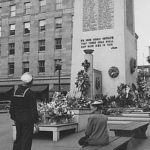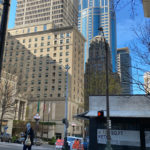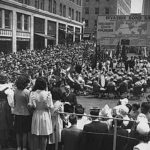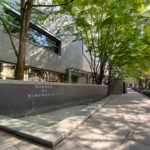All Over The Map: 1940s Victory Square in Seattle and plans for a COVID-19 monument
Apr 10, 2020, 9:51 AM | Updated: Apr 13, 2020, 7:14 am
A full city block in downtown Seattle was known for most of the 1940s as “Victory Square.” During World War II, it featured a memorial with a growing list of Seattle and King County residents who died while serving in the military.
While researching and visiting Victory Square this week, it got me wondering if it might be time to start thinking – if only just a little bit – about a COVID-19 monument.
Victory Square took up all of University Street between 4th Avenue and 5th Avenue, where nowadays the entrance to the Fairmont Hotel is on the south side, and Rainier Tower (and the remains of Rainier Square) is on the north side.
The old Metropolitan Theater stood where that hotel entrance is now, but it was torn down in the 1950s to create a new driveway for what was then called the Olympic Hotel.
The official grand opening of Victory Square was held on May 2, 1942, just months after the United States had entered World War II. Conception and construction of the various elements, and coordination of the many events held there, was the work of the Seattle Advertising Club, with assistance from local businesses and government.
Victory Square evolved during the war, but it mainly served as a place where concerts and other entertainments were held to boost morale during World War II and to sell war bonds.
Celebrities would appear there often – some of the notables include Bob Hope, Lana Turner, and Al Jolson – as well as military bands and local choirs. KIRO Radio’s studio was right across the street in the basement of the Cobb Building, and KIRO staff often emceed events or even just read the latest war news to the crowd over the PA system.
KOMO and KJR, then both owned by the Fisher family, were also nearby in the Skinner Building (home of the 5th Avenue Theatre), and their staff participated as well.
At the west end of Victory Square near 4th Avenue was a replica of Monticello, Thomas Jefferson’s home, that was roughly the size of a small cabin (the stage was on the east side of the structure). At the east end near 5th Avenue was a Washington Monument replica standing 75 feet tall, made from a wooden frame and clad in plywood.
Both monuments were designed by Seattle architect George W. Stoddard, who just a few years later would design Memorial Stadium. These wooden temporary monuments were right in the middle of the road; when the street wasn’t completely closed down for events, traffic would just veer around either side.
At some point during the summer of 1942, Victory Square organizers started to add the names of Seattle and King County war dead to the sides of the Washington Monument, and this practice was carried on throughout the war. A gas flame was added near the base of the monument, and this part of Victory Square became a place of genuflection and a highly visible, tangible reminder of the human cost being paid, in near real time, to fight the war.
The big public events at Victory Square pretty much ceased within a month or two of the war ending in August 1945, but the Washington Monument — which came to be called simply “the pylon” — remained for years, while civic leaders hemmed and hawed about creating a permanent war memorial.
The City of Seattle convened meetings, and newspapers published editorials supporting some kind of permanent tribute to the lives lost. Some wanted the memorial at Victory Square, others were open to building something elsewhere. In 1947, Memorial Stadium was dedicated, but it paid tribute only to war dead who had attended Seattle Public Schools.
Finally, in 1948, the pylon started to visibly fall apart, and its many flags often appeared neglected and tattered. Money was earmarked by the City Council and repairs were made. Around that same time, plans came together to build a permanent memorial at the new Public Safety Building.
In January 1949, the pylon was dismantled, with the boards carrying the names of war dead being taken by the city for safekeeping. Where those boards – or, for that matter, any pieces of the pylon – ultimately ended up is unknown; checks with MOHAI and the City of Seattle failed to turn up any evidence.
The new permanent memorial was dedicated at the Public Safety Building in 1951. When that building was demolished (the vacant pit remains just west of City Hall) a new permanent memorial, the Garden of Remembrance, was dedicated on the west side of Benaroya Hall.
The site of Victory Square was commemorated with a brass plaque dedicated on the south side of the old White-Henry-Stuart Building later in 1949; that plaque now lives in the Skinner Concourse that connects Rainier Square to the Skinner Building.
On Thursday, site management company UNICO Properties spokesperson Jack Noftsger tracked down the plaque on display in the concourse – which is closed to the public due to the pandemic – and shared a photo.
Wouldn’t that plaque be more appropriate in what used to Victory Square, maybe on the side of the new version of Rainier Square currently under construction?
Contacted late Thursday, spokesperson Victor Balta of the University of Washington — owner of the downtown real estate known as the “Metropolitan Tract” that includes Victory Square — said in an email:
“The plaque is going to be reinstalled as part of a historical display in the revamped concourse. It’s a special plaque and commemoration, and we’re thinking about how to do the re-dedication right. I also wanted to note that there is a new plaque commemorating the history of Victory Square that was placed about three years ago on the north side of the Fairmont Olympic exterior wall (east of the main roundabout entrance).”
And it’s also only a few tiny plaques here and there that memorialize the victims of the 1918-1919 influenza. Then, as now, health care professionals and others died “in the line of duty” during that crisis.
During the current pandemic, so many local people are risking their health and even their lives to serve the public, whether first responder, transit employee, food service worker or so many others. It’s not exactly wartime, but it’s probably (hopefully) the closest thing to it that we’ll ever experience in the United States.
If and when this community chooses to create some kind of lasting memorial to those who give their lives during this crisis, it might be unlike any other memorial or monument that’s come before. Whatever it is and wherever it ends up being built, let’s hope it’s bigger than a plaque, and more permanent than Victory Square.
You can hear Feliks every Wednesday and Friday morning on Seattle’s Morning News and read more from him here. If you have a story idea, please email Feliks here.






















